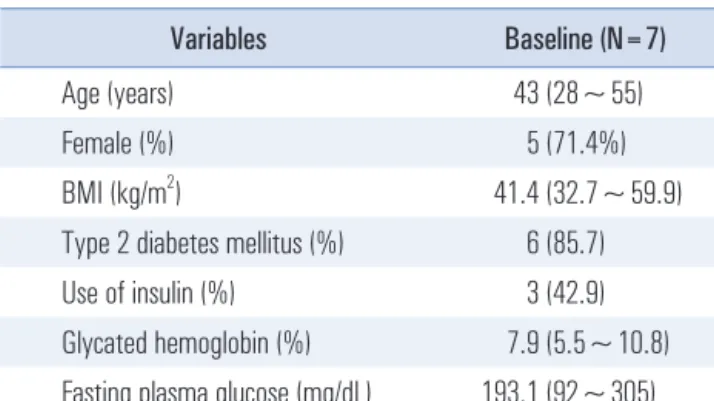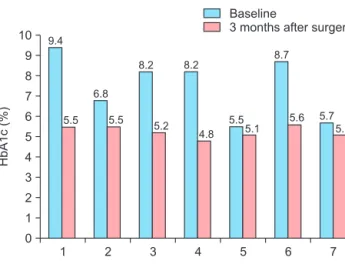Initial Experience with Laparoscopic Loop Duodenojejunal Bypass with Sleeve Gastrectomy in Korean Obese Patients
Sang Hyun Kim, M.D., Ph.D.
1, Kyung Yul Hur, M.D., Ph.D.
1, Yoona Chung, M.D.
2, Yong Jin Kim, M.D., Ph.D.
21
Department of Surgery, Soonchunhyang University Hospital Seoul, Soonchunhyang University School of Medicine,
2Department of Surgery, H plus Yangji Hospital, Seoul, Korea
Laparoscopic loop duodenojejunal bypass with sleeve gastrectomy (LDJB-SG) has theoretical advantages compared with laparoscopic Roux-en-Y gastric bypass. We performed 7 cases of LDJB- SG from May 2019 to September 2019. All procedures were successfully completed by laparoscopy.
The mean operative time was 282.9 (210~335) minutes and the mean estimated blood loss was 82.9 (20~150) ml. There was no intraoperative complications, however, there was 1 case of postoperative anastomotic leakage. The average length of postoperative hospital stay was 5.3 (3~12) days. The mean body weight at baseline was 117.1 (88.4~151.1) kg, and was decreased to 90.4 (69.4~130.9) kg at postoperative 3 month. The mean of HbA1c at baseline was 7.6 (5.5~9.4) %, and was decreased to 5.3 (4.8~5.6) % at postoperative 3 month. Although LDJB-SG is a technically demanding procedure, it can be a feasible and safe procedure if the learning curve can be overcame.
Keywords: Loop duodenojejunal bypass, Sleeve gastrectomy, Metabolic surgery, Obesity, Weight loss
Supplementary video file: This article contains supplementary material (https://doi.org/10.7602/
jmis.2020.23.1.52).
Received December 4, 2019 Revised February 4, 2020 Accepted February 26, 2020
Corresponding author Yong Jin Kim
Department of Surgery, H plus Yangji Hospital, 1636 Nambusunhwan-ro, Gwanak-gu, Seoul 08779, Korea Tel: +82-2-2018-6159
Fax: +82-70-4665-9090 E-mail: yjgs1997@gmail.com
ORCID:https://orcid.org/0000-0003-1222-2121
This is an Open Access article distributed under the terms of the Creative Commons Attribution Non-Commercial License (http://
creativecommons.org/licenses/by-nc/4.0/) which permits unrestricted non-commercial use, distribution, and reproduction in any medium, provided the original work is properly cited.
Copyright © 2020 The Journal of Minimally Invasive Surgery. All rights reserved.
Journal of Minimally Invasive Surgery
J Minim Invasive Surg 2020;23(1):52-56
INTRODUCTION
Huang et al.
1introduced the laparoscopic loop duodenoje- junal bypass with sleeve gastrectomy (LDJB-SG) procedure in 2011. The LDJB-SG has theoretical advantages over a laparoscopic Roux-en-Y gastric bypass (LRYGB). First, pres- ervation of the pylorus can reduce the possibility of dumping syndrome, bile reflux, and marginal ulcers. Moreover, it can reduce the postprandial glucose excursions in diabetic patients after bariatric surgery.
2,3Second, endoscopic surveillance of the remnant stomach is accessible after LDJB-SG; this is par- ticularly important in Asia, where gastric cancer is prevalent.
4Third, the number of anastomoses is reduced to one, and the
possibility of an internal hernia and anastomotic complica- tions, such as leakage or stenosis, can be reduced in LDJB- SG. Despite these advantages, the procedure is not practiced widely because of the technical difficulties of a duodenal dissection and hand-sewn duodenojejunal anastomosis. This paper reports the initial experiences with LDJB-SG in Korean obese patients.
PROCEDURE
Under general anesthesia, the patient was placed in the su-
pine position with their legs pulled apart. Five or six trocars
were used, as shown in Fig. 1. The surgeon stood on the right
side of the patient; the scopist stood between the legs of the patient while an assistant stood on the left side of the patient.
Liver retraction was achieved using the sling method with a straight needle or Nathanson retractor. Devascularization of the greater curvature of the stomach (4 cm from the pylorus to the left crus of the diaphragm) was performed with a Li- gasure
TM(Medtronic). Using a 38 Fr bougie placed within the stomach, a sleeve gastrectomy was performed with sequential shoots of the Signia
TMstapling system (Medtronic). The ini- tial firing was performed with a black cartridge, followed by purple cartridges. A reinforcement suture of the staple line on the sleeved stomach was added in some cases. A stay suture was placed at the distal part of the staple line on the stomach for counter-traction and a better surgical view of the 1st por- tion of the duodenum. Window formation at the supra- and infra-duodenal areas and tunneling behind the duodenum us- ing a retractor for gastric banding (Karl storz) was performed.
The duodenum was retracted anteriorly using umbilical tape to insert the stapler easily, and then the duodenum was tran- sected using the curved tip of the tan cartridge. The omentum was divided in some cases to avoid tension of the anastomosis during an antecolic reconstruction. Two hundred centimeters of the jejunal loop from the ligament of Treitz was measured and fixed to the pylorus using a stay suture. Enterotomy from 1.5 cm to 2 cm at the 1st portion of the duodenum and jeju- num was done, and hand-sewn anastomosis with V-LOC
TM90 absorbable 3-0 (Medtronic) was performed in an isoperistaltic manner. An air leak test was performed with air insufflation through the inserted bougie to check the anastomosis. An interrupted suture with non-absorbable thread (2-0 Ethibond
Excel
®; Ethicon) was then done between the antrum and the jejunum a few centimeters proximal to the duodenojejunos- tomy. The interrupted suture between the His angle of the stomach and the left crus was performed to prevent gastro- esophageal reflux. A few interrupted sutures between the sleeved stomach and the retroperitoneum were performed to fix the stomach and prevent twisting of the stomach. A con- tinuous suture with V-LOC
TMnon-absorbable 3-0 (Metronic) was then used to close the Peterson defect. Finally, a Jackson- Pratt drain was inserted behind the duodenojejunal anastomo- sis along the staple line of the stomach.
This study was approved by the Institutional Review Board of Soonchunhyang University Hospital Seoul.
RESULTS
In the author’s institution, patients who have uncontrolled type 2 diabetes mellitus (T2DM) with glycated hemoglobin (HbA1c) ≥8.0% or T2DM using insulin, or super-obese pa- tients with a body mass index (BMI) ≥50 kg/m
2were eligible for bypass surgery, such as LDJB-SG or LRYGB. The surgical procedure is determined according to the endoscopic findings, severity of gastroesophageal reflux symptoms, familial history of gastric cancer, cigarette smoking, the persistence of non- steroidal anti-inflammatory drugs, and the patient’s preference for one of the two procedures.
Seven cases of LDJB-SG were performed from May 2019 to September 2019. All procedures were completed success- fully by laparoscopy. Table 1 lists the patient baseline char- acteristics. The average age was 43 years (range 28~55 years);
five patients (71.4%) were female, and the mean body mass index (BMI) was 41.4 (32.7~59.9) kg/m
2. Six patients (85.7%) had T2DM, and three patients (42.9%) were using insulin. The mean HbA1c and mean fasting plasma glucose (FPG) levels were 7.9 (5.5~10.8) % and 193.1 (92~305) mg/dl, respectively.
Table 2 lists the perioperative outcomes. The number of tro- cars used was 5.3 (5~6), and the number of sling methods for Table 1. Patient’s characteristics at baseline
Variables Baseline (N=7)
Age (years) 43 (28~55)
Female (%) 5 (71.4%)
BMI (kg/m
2) 41.4 (32.7~59.9)
Type 2 diabetes mellitus (%) 6 (85.7)
Use of insulin (%) 3 (42.9)
Glycated hemoglobin (%) 7.9 (5.5~10.8) Fasting plasma glucose (mg/dL) 193.1 (92~305)
Nathanson retractor or Sling method
5 mm 5 mm
15 mm
12 mm
12 mm
Fig. 1. Position of the trocars in laparoscopic loop duodenojejunal bypass
with sleeve gastrectomy.
liver retraction was five (71.4%). The mean operative time was 282.9 (210~335) minutes and the mean estimated blood loss was 82.9 (20~150) ml. No intraoperative complications were encountered, but there was one case with postoperative com- plications. This was the first case of LDJB-SG and the patient was male, 180.4 cm in height, 147.7 kg in weight, and a BMI of 45.2 kg/m
2. He had a high fever over 38°C on postopera- tive day (POD) 4. The abdominopelvic computed tomogram (APCT) revealed mild mesenteric fat infiltration with a small amount of fluid collection and air densities in the upper abdo- men. Anastomosis leakage was suspected and the administra- tion of intravenous broad-spectrum antibiotics was started.
After seven days, APCT was re-checked with gastrograffin.
No leakage of contrast material was observed and the level of mesenteric fat infiltration had improved. The patient was dis- charged on the next day. The average length of the postopera- tive hospital stay was 5.3 (3~12) days. One case of readmission was encountered. She had a history of cerebral infarction and
she was readmitted due to a severe headache on POD 14. She was discharged four days after conservative management.
Fig. 2 presents the individual body weights. The mean body weight at the time of surgery was 117.1 (88.4~151.1) kg, which decreased to 99.5 (78~140.6) kg and 90.4 (69.4~130.9) kg at postoperative one and three months, respectively. Fig. 3 shows the individual’s HbA1c levels. The mean of HbA1c at the baseline was 7.6 (5.5~9.4) %, which decreased to 5.3 (4.8~5.6)
% at postoperative three months.
DISCUSSION
LDJB-SG is a novel bariatric procedure that was introduced less than 10 years ago. Although it is not popular, the number of cases, particularly in Korea, is very small.
5To the best of the authors ’ knowledge, there are no reports of the long-term outcomes of LDJB-SG, nor have there been randomized con- trolled trials comparing LDJB-SG with other bariatric pro- cedures, such as LRYGB or laparoscopic sleeve gastrectomy (LSG). A few studies showed that LDJB-SG is a relatively safe and effective metabolic surgery with significant weight loss and resolution of the co-morbidities during a short- and mid- term follow up period.
1,6-8Other studies compared restrospec- tively LDJB-SG with other procedures, such as mini-gastric bypass (MGB), LRYGB or LSG.
9,10Lee et al.
9reported that LDJB-SG has a significantly longer operative time and higher weight loss at one year after surgery than MGB or LRYGB. In addition, Huang et al.
10suggested that LDJB-SG was compa- rable to LRYGB in terms of weight loss, glycemic control, and co-morbidity resolution in T2DM patients with a BMI <35 kg/
m
2in the short-term. According to one study comparing the one-year results between LDJB-SG and LSG, LDJB-SG was superior to LSG in T2DM remission, triglyceride improvement,
1 10
9 8 7 6 5 4 3 2 1
HbA1c(%)
Patient 0
2 3 4 5 6 7
Baseline
3 month s after surgery
9.45.5 6.8
5.5 8.2
5.2 8.2
4.8 5.5
8.7
5.7 5.1
5.6 5.1
Fig. 3. Individual’s glycated hemoglobin (HbA1c) levels after laparoscopic loop duodenojejunal bypass with sleeve gastrectomy.
Table 2. Perioperative outcomes
Variables Number/mean (N=7)
Number of trocar 5.3 (5~6)
Sling method by liver retraction 5 (71.4%) Operative time (minutes) 282.9 (210~335) Estimated blood loss (ml) 82.9 (20~150) Intraoperative complication 0 (0) Postoperative complication 1 (14.3) Postoperative hospital stay 5.3 (3~12)
Readmission 1 (14.3)
1 160 140 120 100 80 60 40 20
Bodyweight(kg)

